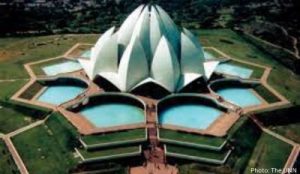The incredible architectural marvel of Lotus Temple located in New Delhi, is a Baha’I House of Worship. In the early 21st century it was one of only nine mashriqs in the world.The Lotus Temple derives its name from its design. Like every other Bahāʾī mashriq, it is characterized by a nine-sided construction, in keeping with the Bahāʾī belief in the mystical properties of the number nine. Set on an elevated plinth in a 26-acre (10.5-hectare) expanse of landscaped gardens and surrounded by nine pools bordered by red sandstone walkways, the white marble edifice rises to a height of more than 130 feet (40 metres).
The Lotus Temple complex comprises 27 independent marble “petals,” which are clustered into groups of three to form nine sides (through which open nine entrances into a central space) and into groups of nine to form three concentric rings. Petals in the first ring face outward, forming canopies over the nine entrances. The second ring covers the outer hall. In the innermost ring, the petals curve inward to partially enclose the central prayer hall, which accommodates about 2,500 people. The top of the structure appears open but actually contains a glass-and-steel roof that admits natural daylight. The overall effect is that of a floating lotus flower on the verge of blooming and surrounded by its leaves.

The teachings of the Baha’i faith hold that there is only one God, one religion, and one human race. The prominent lotus-like structure transcends all religious boundaries and welcomes humanity without any significant qualifications. The lotus temple is manifestation of Baha’iFaith’s principles, emphasizing unity, peace, and spiritual harmony.
History and Architecture
The Lotus Temple was designed by the Iranian architect Fariborz Sahba. The architecture is a merged design inspired from both Eastern and Western styles. The structure consisted of 27 free-standing marble-clad petals. The petals were arranged in clusters of three to form nine sides. The aesthetic appeal of the temple serves as a metaphor to the interconnectedness of all religions. The foundation for the temple was laid by Ruhiyyih Khanum and dedicated the temple on 24t December 1986. The Lotus Temple was built with marble that came in over 10,000 distinct sizes.
Things to do
- Tourist Attraction
The Lotus Temple is now a popular tourist destination in Delhi, drawing millions of people every year. Part of what makes it so popular is its unique architecture and calm atmosphere.
- Spiritual Retreat
The Lotus Temple provides a striking contrast to the chaotic urban environment outside its gates with its surrounding verdant gardens and reflecting pools. The serene atmosphere encourages introspection and contemplation, making it a haven for anyone looking for comfort in the middle of a busy metropolis. With its serene surroundings, the Lotus Temple turns into a haven for people looking for spiritual renewal and inner serenity.
- Architectural Excellence
The Lotus Temple is renowned for its brilliant architecture and has received many honours and awards. The creative combination of artistic imagination and technical perfection is demonstrated by the inventive design and material selection.
